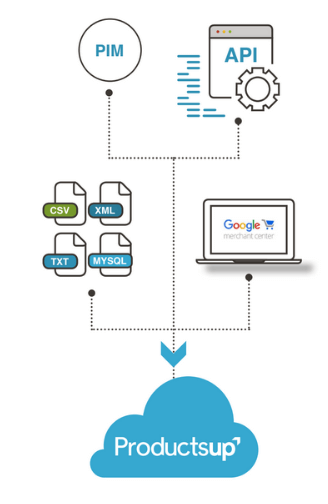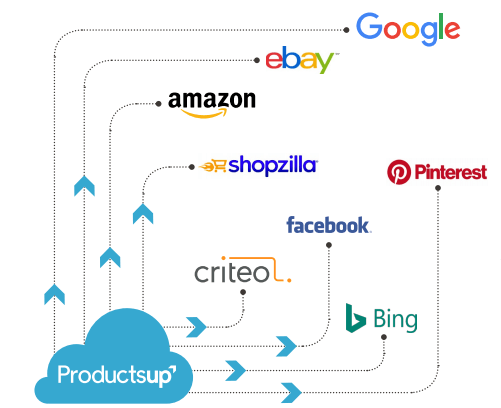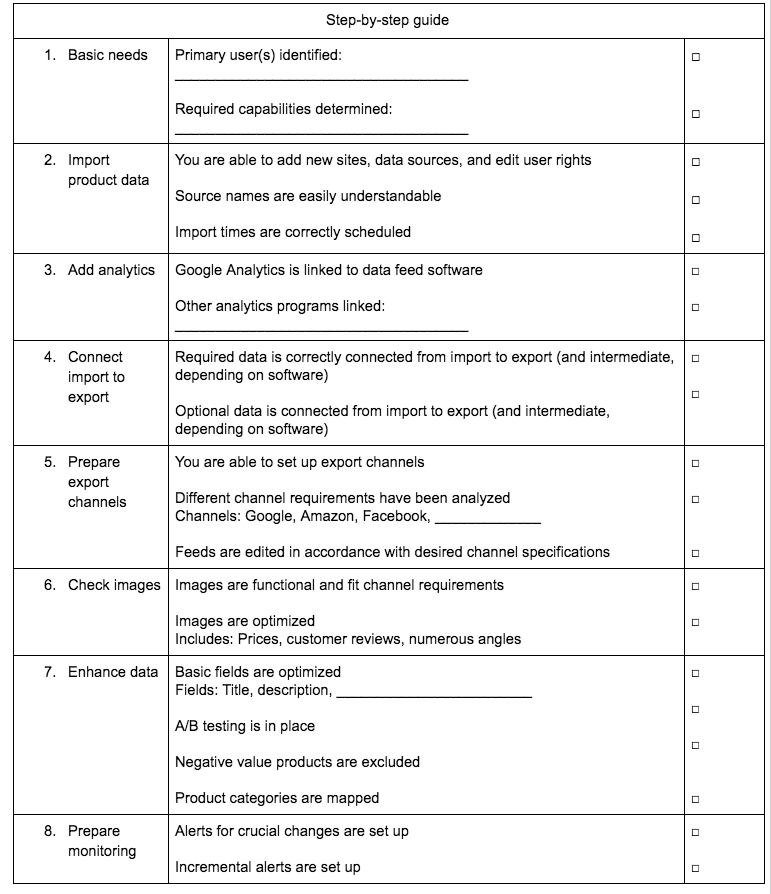Want to migrate to a new ecommerce product data management software? Here’s how to get started. Your data feeds will thank you.
Maybe your current product data management solution is too slow. It’s not intuitive. It takes too much time to make changes. Or maybe your team is looking for new features for optimization, and you found a platform that adds value through analytics tools, can drive better CTRs with amazing image design options, or simplifies and automates huge swaths of work you’d rather not be doing.
Whether you’re already using a great platform or your product content is spread across dozens of random files, there are plenty of reasons to switch to a new product data management software. While it can add a new stress to an already busy workload, there’s no reason to fret about the data migration and integration process.
Why switch platforms?
- You need to edit and optimize existing feeds more quickly or in bulk
- You’re not happy paying more every time you add an export channel
- Your current solution is too complicated and you need more support
- You need an easier, marketing-friendly solution
Remember, the product data migration won’t be as intensive as other types of data migration. In fact, there should be little to no down time, when performed correctly.
This process can take time, so the team should be fully committed and confident that the change makes fiscal sense and will drive results.
First things first: talk to your marketers. Before the data migration process even begins, meet with your solution provider. More importantly, meet with your marketing team and determine exactly what you need from data feed management software. These are the individuals who will not only be using the next platform. Their skills and expectations should be carefully weighed and discussed with the solution provider beforehand.
This may be the entire marketing team or an ecommerce manager, so be certain that these individuals can find actual value in the solution, and that they can use the tool confidently and effectively.
Ready to get migrating? Here’s what you need to know.
The migration process: simplified
Worried about downtime when your ads aren't running? No reason to stress. Because any existing data feed imported will continue to run as scheduled, there’s no pressure to work fast or fear a complete breakdown of your ads.
There are three steps in the technical migration process: import, connection, and export.

1. Import
From where do you pull your data feed? You’ll need to input this information into your new product data software. Here are some sources you might be using:
- FTP
- Shopping platforms (Google Merchant Center, AliExpress, Amazon API)
- Shop systems (Shopify, WooCommerce, Prestashop)
- Cloud services (Google spreadsheet, Microsoft Azure)
- PIM/PMS (akaneo, Salsify, SAP Hybris)
- Tracking systems (DoubleClick Search, Google Analytics, Webtrekk)
- Other (Productsup API, JSON Download, YouTube Fetch)
While this process is mostly straight forward, there are a couple of questions you should ask in the process.
| *Do you need to set up or generate unique IDs for tracking purposes?* | If you’re going to require unique IDs in order to export properly, consider generating those now, most likely from the gtin. |
| *How will you differentiate different sources?* | URLs can be very unclear, making it difficult to determine which feed is which. Additional feeds, intended to enhance the main feed, will include additional attributes and columns to supplement the main feed. Files should always be clearly labelled and easy to differentiate. |
| *When should the file be uploaded?* | Get your scheduling straight from the get-go. If a product data file is updated every day at 12:00, don’t schedule daily FTP imports for 10:00. |
2. Connect
That raw data feed you just imported needs to be edited and formatted to fit your ecommerce export channels. That’s why this step is crucial. However, it will also vary depending on the selected software and existing data. You may:
- Use simple coding to connect attributes
- Create multiple edits for different required attributes
- Drag-and-drop rules for bulk edits
| Plan for the entire process to take some weeks | Leverage automapping whenever possible, especially if there are multiple export channels |
| Understand the software’s editing methods; is it drag-and-drop or does it require an amount of coding? | Use preview options to immediately see and confirm data before it goes live |
3. Export
That raw data is now cleaned up and functional, so it’s time to prepare it for export. Because every channel is different, you’ll need to prep data feeds for unique each channel. How much time and resources this requires will also vary, as some channels can be more strict or complicated than others.

- Google is one of the strictest channels. Be sure to add your google_product_category and double check that your images follow channel requirements.
- Images sent to Facebook should be particularly well-groomed, as the channel is highly visual.
- If you'll be running travel ads, be sure to include any travel-specific attributes. Google and Facebook, in particular, have a number of requirements.
- For other channels, always review the exact attributes requirements.
Whether you’re exporting to Google Merchant Center, TripAdvisor, WalMart or anywhere else, you’ll need any and all login credentials in order to export. Be sure to gather your usernames and passwords for the export channels you use.
You should also carefully consider which products you do or do not want to export. You’ll obviously want to include any products that drive returns and results, and even those that perform decently. But what about those low margin products? They may be better off excluded from export. This step will also be part of the ongoing optimization process, so get comfortable understand your products’ performance.
Once you can export your feed correctly, it's time to stop exports from any previous software solutions.
Fine tuning: how to make the migration process easy
Much of what makes this process easier will be knowledge. Are you and your team absolutely aligned and know what you need? Before you even get started, pinpoint who will be the most important individuals in this process. Who is in charge? Who has been using the platform in the past and who will be using the platform in the future? Define exactly what these individuals will need and ensure that they are kept in the loop at every step.
This is especially true at the enterprise level. Define all stakeholders in the migration process. Who is the point of contact for your team and for the new solution provider? Have these people on call so the transition goes smoothly.
For enterprise, small businesses, and everything in between, here's a step-by-step checklist to get you through the migration process.


![[WP Import] Migrating to new product data management software?](http://images.ctfassets.net/q17uls4wkkdz/70XKBVj8nWmR9StBgVtpxM/b094b8c64171f3280b9fd7a68bd8e53e/switching_data_management_platforms_email_header_600x288px.png?w=1200&h=675&fit=FILL)